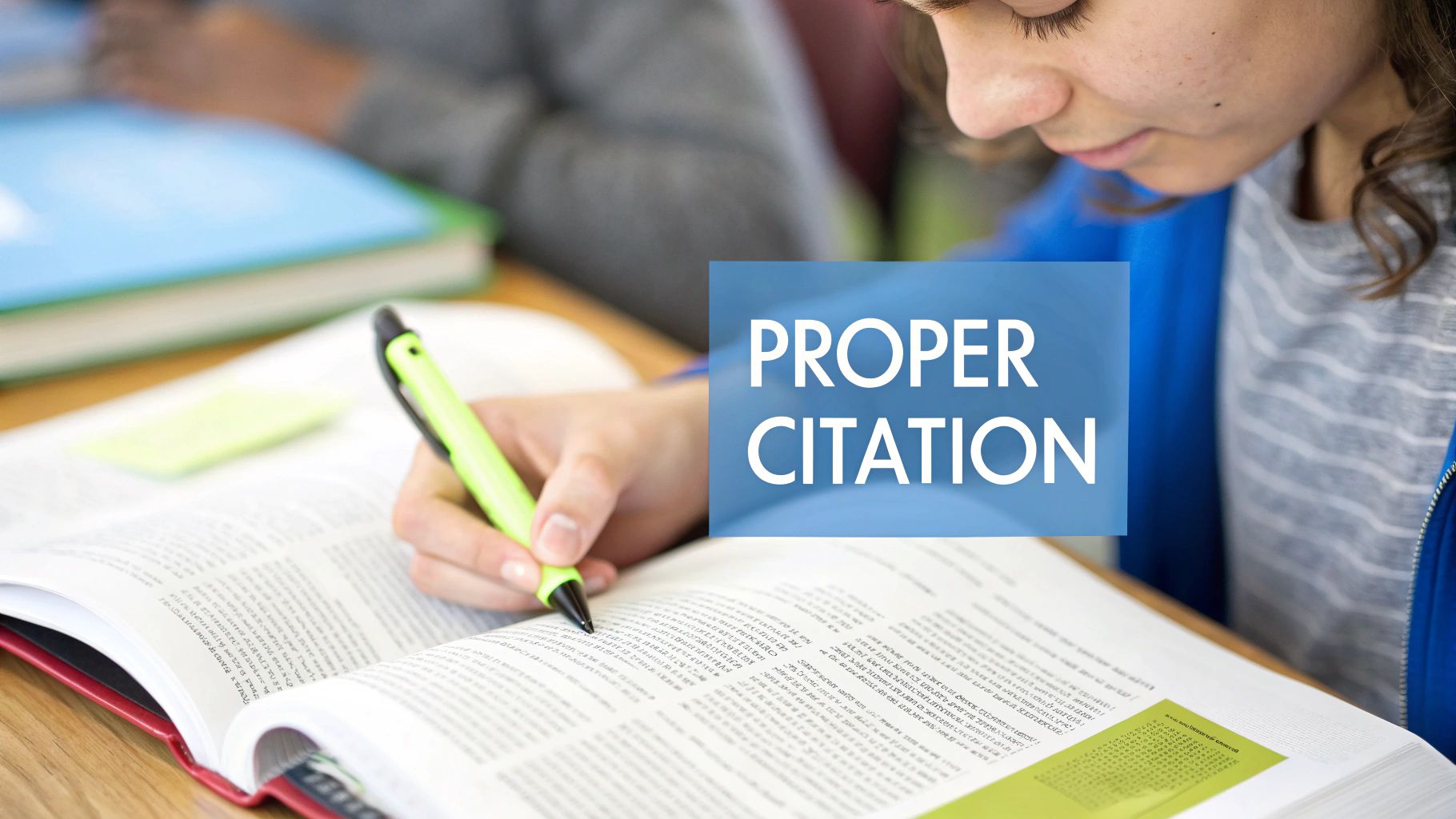Why Citations Matter (And How to Make Them Work for You)

Citations do more than just help avoid plagiarism – they establish the validity of your research and invite readers into an academic dialogue. Good citation practices demonstrate your command of existing research while giving credit where it's due. Understanding why citations matter can help transform them from a tedious requirement into a valuable tool that strengthens your academic writing.
Building Credibility and Strengthening Arguments
Just as a house needs a solid foundation, academic writing requires strong evidence to support its claims. Citations provide that foundation by connecting your ideas to established research and data. For example, when discussing how social media affects mental health, citing peer-reviewed studies adds weight and credibility to your arguments. Beyond just backing up claims, proper citations show respect for other researchers' work while demonstrating your grasp of the field to readers.
Joining the Academic Conversation
Citations help place your work within the broader academic discussion happening in your field. By referencing key studies and theories, you show how your research builds on or challenges existing knowledge. This connects your ideas to ongoing scholarly debates and helps advance understanding in your area of study. Like a musician drawing inspiration from different genres and artists, researchers use citations to acknowledge influences while adding their own unique contributions.
How to Cite Sources Properly: Practical Approaches
Learning citation styles and rules is like picking up a new language – it takes practice but follows consistent patterns. The key is providing enough information for readers to easily find your sources. Here are some practical tips:
-
Choosing the Right Sources: Pick relevant, authoritative sources that strengthen your argument. Focus on recent, peer-reviewed works from respected scholars and publications.
-
When to Cite: Reference any specific facts, data, or ideas that aren't common knowledge. This includes quotes, paraphrased content, statistics, and unique concepts from other works.
-
Making Citations Flow: Blend citations naturally into your writing without disrupting your argument's flow. Rather than repeatedly using phrases like "According to Smith (2020)," try variations like "Recent studies suggest…" followed by the citation.
When you master citation practices, you'll write more compelling academic work that contributes meaningfully to your field. Good citations help you engage with other scholars' ideas while clearly marking your own contributions to ongoing research conversations.
Navigating Citation Styles Without Losing Your Mind

If you're feeling overwhelmed by the variety of citation styles, you're not alone. Many students struggle with properly citing their sources. Let's break down the main citation styles – APA, MLA, and Chicago – into clear guidelines that will help you choose and consistently use the right style for your work.
Demystifying the Big Three: APA, MLA, and Chicago
Each citation style serves a specific purpose in different academic fields, much like using the right tool for a specific job. APA style, used mainly in social and behavioral sciences, emphasizes publication dates to highlight recent research. The humanities prefer MLA style, which focuses on author names and page numbers for literary analysis. Chicago style shines in history and related fields, using detailed footnotes to provide context. For instance, when citing historical documents, Chicago allows you to include specific information about where the document was found in archives.
Choosing the Right Style and Sticking With It
Your university or course guidelines typically determine which citation style to use. If you have flexibility in choosing, pick the style most common in your field. Once you select a style, stay consistent throughout your work. Just as randomly changing fonts would confuse readers, mixing citation styles makes academic writing harder to follow and less credible. Citation tools can help maintain consistency and save time. For more guidance, check out: How to master citations with a generator.
Handling Complex Sources: A Practical Approach
Complex sources like government documents or online content become easier to cite when you tackle them step by step. For government materials, identify the agency that authored the document and when it was published. When citing online sources, include the date you accessed the material since web content can change or disappear. This detail helps readers understand the context of your citation, particularly if the content changes later. When dealing with online sources that lack clear authors, use the organization or website name instead.
Focusing on the Fundamentals: What Matters Most
While citation styles have their unique rules, they share core principles: give readers enough information to find your sources and maintain consistency. These basics form the foundation of proper citation practice across educational institutions. Like learning any new skill, mastering citations takes practice, but the benefits make it worthwhile. Your work gains credibility, your arguments become stronger, and you join the academic conversation more effectively.
Mastering Digital Source Attribution
Proper source attribution is essential when working with digital content like social media posts, webinars, and online databases. While citing these modern sources may seem overwhelming at first, following a systematic approach makes the process straightforward. This section provides practical guidance for accurately citing digital content while maintaining academic integrity.
Citing Social Media: Tweets, Posts, and More
Twitter and other social platforms have become important information sources that require careful citation. For tweets, include these key elements: the author's handle, the complete tweet text in quotes, posting date and time, and specify "Twitter" as the platform. Similar rules apply to Facebook posts and Instagram content – provide the author's name (or username if real name unavailable), the content, posting timestamp, and platform name. This detailed documentation helps readers find original posts, even after modifications.
Navigating the Web: Websites, Blogs, and Online Articles
Web content citation follows clear principles. Begin with the author's name when available, or use the organization/website name if no individual author is listed. Include the article/webpage title in quotes, website name, publication or update date, and URL. For instance, when citing content from an educational technology blog, you would include all these components in your citation, allowing readers to easily locate and verify the source.
Handling Vanishing Content: Archived Pages and Broken Links
Digital content can be temporary – pages disappear and links break. Fortunately, web archives provide a solution. The Internet Archive's Wayback Machine preserves webpage snapshots, offering stable reference points even after original content vanishes. When citing archived material, include both the original URL and the archive URL, plus your access date. This approach ensures your sources remain accessible to readers.
The Importance of Accuracy and Consistency in Digital Citations
Just as with print sources, digital citations demand meticulous attention to detail. Verify all information – usernames, dates, URLs – to avoid errors. Choose one citation style (APA, MLA, or Chicago) and use it consistently throughout your work. This careful approach not only creates a professional document but also helps readers easily track down your sources. By mastering these citation techniques, you'll build stronger research while upholding academic standards in the digital space.
Making Technology Work for Your Citations

Managing citations properly is essential for academic work, but the manual formatting process can feel like a drain on your time and energy. Modern citation management tools offer a practical solution by automating the technical aspects of citing sources. This allows you to spend less time worrying about formatting details and more time focusing on your actual research and writing.
Choosing the Right Citation Management Tool
Finding the best citation tool depends on how you work and what features matter most to you. Zotero provides a free, open-source option with solid core functionality for organizing and citing sources. For those seeking additional capabilities, Mendeley and EndNote offer premium features like collaborative tools and advanced Word integration, though they require paid subscriptions. Consider your specific needs around budget, required features, and ease of use when making your choice.
| Feature | Zotero | Mendeley | EndNote |
|---|---|---|---|
| Cost | Free | Freemium | Paid |
| Open Source | Yes | No | No |
| Word Integration | Yes | Yes | Yes |
| Collaboration | Yes | Yes | Yes |
Building Your Personal Citation System
Getting the most from your citation tool requires developing an organized approach to managing research materials. For instance, you might create collections for different projects and use tags to identify key themes – tagging articles with terms like "climate change" or "renewable energy" makes them easy to find later. Most tools also let you add notes and highlights directly to PDFs, creating a central hub for your research materials. This systematic approach helps you track your work and quickly access relevant sources while writing.
Maintaining and Growing Your Research Database
Your citation database becomes more valuable over time as you add new sources and refine your organization system. Regular maintenance – adding new materials, updating keywords, and checking citation accuracy – keeps everything accessible and useful. Think of it like organizing your digital library: consistent upkeep makes it easier to find what you need. By establishing good habits early, you'll build a reliable system that grows with your academic work and helps you produce well-documented research throughout your studies.
Building Trust Through Proper Attribution

Citing sources correctly does more than satisfy academic requirements – it builds trust with readers and establishes you as a credible researcher. When you properly acknowledge others' work, you show respect for intellectual property while giving readers the ability to verify information themselves. Let's explore the key aspects of effective citation and how it strengthens your writing.
Understanding the Nuances of Paraphrasing, Quoting, and Summarizing
Knowing when to cite is just as important as knowing how. You must credit original sources whenever you include external information, whether through paraphrasing, direct quotes, or summaries. When you paraphrase, you restate ideas in your own words while keeping the core meaning. Direct quotes use the exact original text within quotation marks. Summaries condense longer passages into brief overviews. For instance, in writing about citation styles, you might paraphrase how the Chicago Manual of Style developed over time, quote significant text about its beginnings, or summarize its influence on academic writing. Each method requires proper attribution to the source.
Handling Tricky Attribution Situations: Common Scenarios and Solutions
Some citation situations can be challenging to navigate. For example, when citing information that you found quoted in another source (secondary citation), ideally you should track down and cite the original. If that's not possible, clearly indicate that you're citing through another source. Another common question is whether to cite "common knowledge" – while widely known facts don't need citations, it's better to cite when in doubt. Group-authored content like wikis can also be tricky. In these cases, cite the organization or platform if individual authors aren't clearly listed.
Practical Techniques for Seamless Citation Integration
You can make citations flow naturally in your writing through several techniques. Instead of repeatedly starting with "According to…" try varied phrases like "Research shows…", "Studies indicate…", or "Evidence suggests…" followed by the citation. This creates smoother reading while avoiding repetitive language. It's also essential to master citation formats like APA, MLA, and Chicago style. To help manage sources effectively, you might find it helpful to use a text summarizer to condense research and ensure accurate paraphrasing.
By applying these citation principles consistently, you transform attribution from a basic requirement into a tool that strengthens your writing. Proper citation demonstrates your commitment to academic integrity while building trust with readers. When you acknowledge sources clearly and accurately, you establish yourself as a reliable voice in your field and enhance the overall impact of your work.
Leveraging Citations for Research Impact
Citations serve as more than just academic requirements – they are key tools for expanding your research's reach and credibility. When used thoughtfully, citations help position your work within scholarly discussions, build connections with other researchers, and demonstrate your command of the field.
Building Academic Networks Through Thoughtful Attribution
Citations act as bridges connecting different scholarly works and researchers. Each time you cite another scholar's work, you create a meaningful link that shows how ideas build upon each other. For instance, by citing established researchers in your field, you can draw their attention to your work, potentially leading to valuable collaborations. Well-documented citations also make it easier for others to find and reference your research, helping expand your academic influence.
The Influence of Citation Metrics on Academic Recognition
While citation counts are a common measure of research impact through metrics like the h-index and impact factor, they tell only part of the story. The context and quality of citations matter significantly. A small number of citations in highly respected journals can carry more weight than numerous citations in less prominent publications. The key is focusing on meaningful citations that demonstrate your work's relevance and contributions.
Strategic Citation: Positioning Your Work Effectively
Effective citation involves carefully selecting sources that strengthen your arguments and show where your work fits in the field. Rather than including every remotely related citation, focus on choosing sources that directly support your key points and highlight your unique contributions. Think of it like building a compelling case – you want to present the most relevant evidence that demonstrates both your understanding of existing research and what's new about your work. Learn more in our article about how to master grammar for clear and concise writing.
Insights From Leading Scholars
Experienced researchers understand how strategic citation shapes research narratives. They thoughtfully select citations to establish their expertise while showing what makes their work novel and important. Their citation choices reflect deep knowledge of their field's key works and conversations. This careful approach to citation helps build their scholarly authority and influence.
Proper citation practices do more than just avoid plagiarism – they help create trust with readers and strengthen the overall quality of academic work. These foundational skills support making meaningful research contributions. Enhance your academic writing with SmartStudi – comprehensive AI-powered tools to help you research, write, and cite effectively. Visit SmartStudi today to learn how we can support your academic goals.
